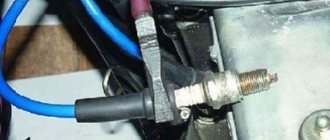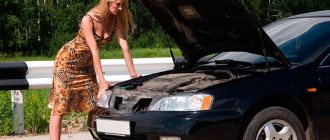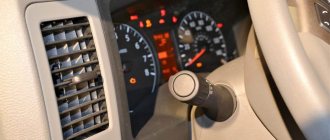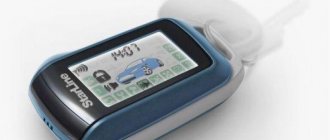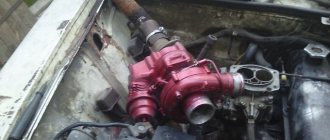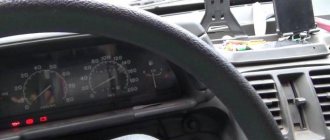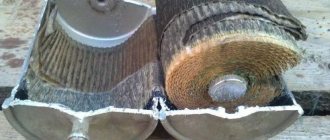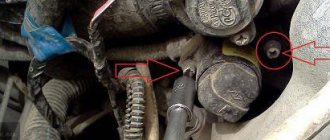The products of the domestic automobile industry are not of high quality, and at first glance it is not so easy to determine the common reasons why the VAZ 2106 stalls or does not start at all. Malfunctions can be in everything - in electrical equipment, in the ignition system or in the power system. Perhaps the spark has disappeared on the VAZ 2106 or it is related to the idle air regulator. Therefore, to help the car figure it out, let’s look at the main reasons why the car won’t start and stalls. To troubleshoot problems, we will study useful recommendations from specialists.
If the car won't start
If the VAZ 2106 does not start, you must first identify the true reason. The probable causes of such a problem and possible ways to solve it are as follows.
- The car may not start due to faulty breaker contacts. To confirm or eliminate the risk of such a malfunction, it is necessary to check the condition of the contacts mentioned for the presence of gap violations or oxidation (burning) of the working surfaces. In the first case, you will need to adjust the gap, in the second, you will need to clean or replace the working surfaces. The compression spring will also need to be replaced if necessary.
- The problem may lie in the low voltage wiring of the VAZ 2106 car or in loosening (oxidation) of the wire terminals. You should check the wires going from the ignition coil to the distributor for breakdown and short circuit. There may also be problems with the ignition switch, which needs to be checked, and if it is faulty, it must be replaced or its contact group must be changed.
- There is a possibility of failure of the ignition coil, that is, the spark in the VAZ is lost. Perhaps the problem is a short circuit in the primary winding of this coil, which can be corrected by swapping high-voltage wires. If a spark on a VAZ 2106 appears in a place where it was not there before, but disappears on a new one, this indicates a fault in the spark plug wire.
- Problems with ignition distribution. The distributor capacitor may be broken; therefore, for normal operation of the car, it must be replaced. It also happens that the distributor is installed incorrectly, this leads to the car jerking during acceleration and then stalling.
The starter works, the engine starts and then stalls
In some situations, the car owner cannot start the engine of his “six” even if the starter is working properly. It looks like this: after turning the ignition key, the starter makes two or three turns, the engine “seizes”, but literally stalls a second later. This happens because of this:
- The fuel pump is not working properly. The situation is simple: very little fuel is supplied to the combustion chamber, and literally after one engine stroke the supply of the fuel mixture stops. There is only one way out: remove the pump, disassemble it and carefully inspect it for wear and mechanical damage. If the problem is really in it, change it;
- the fuel line is clogged. This is another reason why little fuel mixture enters the combustion chambers of the “six”. It's no secret that the quality of gasoline in our country leaves much to be desired. Modern gasoline contains a lot of foreign impurities, which are gradually deposited on a variety of surfaces - from the inner walls of combustion chambers to fuel pipes. If the fuel pump and starter are working properly, but the car still won’t start, then it’s time to remove and clean the fuel line. This is best done using ordinary kerosene;
- one or more injectors are clogged. If checking the fuel pump and fuel pipes does not lead to anything, there is one more option: unscrew and check the injectors. They keep getting clogged because of the same low-quality gasoline. And when clogged, they wash everything in the same kerosene;
- armored wire closure. If no problems have been identified with the fuel supply system, but the car still does not start, you should pay attention to the ignition system, and in particular, to the so-called armored pipes. If the integrity of the insulation of one or more wires is broken, and the insulation at the damage site turns black, then there is a short circuit. A spark plug with a damaged wire cannot produce a spark normally, as a result the engine stalls before it can start. There is only one way out of this situation: purchasing and installing a new set of spark plug wires;
If at least one high-voltage wire breaks down, you will have to buy a new set - Timing belt misalignment. The timing belt, like all other parts of the 6 engine, wears out over time. Sometimes it happens that it jumps off the timing shaft gear and moves a couple of teeth. As a result, the timing of the valve timing is disrupted and the engine does not start. If there is a suspicion that the belt is misaligned, the driver will have to unscrew the timing cover (it is held on by six bolts) and inspect the shafts. The worn belt is replaced with a new one, after which the timing phases are adjusted. You can learn how this is done from the VAZ 2106 operating instructions.
The timing belt on a VAZ 2106 may fly off or shift by several teeth, which will cause a timing shift
Video: poor engine starting in summer due to accumulation of gasoline vapors
Why does the car stall while driving?
As for the most common malfunctions that many drivers of VAZ cars encounter, the list of common reasons includes those that lead to the fact that the domestic car 2106 stalls while driving. Let's look at them in detail.
- Low quality of fuel used. This is where experts recommend starting to look for the source of the problem. If, when draining the old fuel and replacing it with a new one, you are lucky and the car starts, you can confidently say that you should not skimp on the quality of gasoline for your car.
- Candles. Often, after changing the fuel and the problem persists, that is, the VAZ still does not start, suspicion falls on the spark plugs. You should check their condition after they are unscrewed and, if necessary, replace them with new ones.
- Fuel filter. Very often, a clogged filter can provoke interruptions in the fuel supply, as a result of which the VAZ 2106 stalls while driving. To eliminate the problem, it is enough to replace the fuel filter.
- Problems with the air filter are solved using the same method as with the fuel filter. A clogged filter does not allow air to pass through, which leads to engine pressure, that is, a drop in power. This way, the combustion process of the mixture will not take place, and as a result, the engine will stall.
- The problem is the fuel pump. A faulty fuel pump causes the VAZ 2106 to stall or not start at all. Treatment is checking the pump followed by repair or replacement.
- Battery: oxidation or poor terminal contact. The terminals should be checked, and then the battery should be cleaned or replaced.
- If the engine stalls while driving and won't start again, the cause may be the generator, which is not providing a charge. And since the car is powered only by the battery and, as you know, it doesn’t last long, the car starts working on the battery until it is completely empty.
- In modern brands, the cause of breakdown can be faulty electrical equipment. With such a problem, it is better to immediately contact specialists, because without experience and knowledge, you can replace half a car, but not get rid of the problem.
This concludes the review of the reasons leading to the VAZ 2106 not starting or stalling while driving. Spare no effort, time and financial resources for the well-being of your car, and it will respond with high-quality and long-term service.
As a rule, the true cause of the breakdown is revealed quite simply. And even a car owner who does not have deep knowledge of vehicle repair can easily correct problems that arise that are accompanied by incorrect behavior of his car.
Popping sound when starting the VAZ 2106 engine
Popping noises when starting the engine is another unpleasant phenomenon that sooner or later every owner of a “six” encounters. Moreover, the car can “shoot” both at the muffler and at the carburetor. Let's consider these points in more detail.
Popping sounds in the muffler
If the “six” “shoots” at the muffler when starting the engine, it means that the gasoline entering the combustion chambers has completely flooded the spark plugs. Fixing the problem is quite simple: you need to remove the excess fuel mixture from the combustion chambers. To do this, when starting the engine, press the gas pedal all the way. This will ensure that the combustion chambers are quickly purged and the engine will start without unnecessary pops.
The photo clearly shows that the contact part of the spark plug is completely filled with the fuel mixture
More information about the VAZ 2106 muffler: https://bumper.guru/klassicheskie-modeli-vaz/dvigatel/glushitel-vaz-2106.html
The problem is especially relevant in winter, when starting “cold”. After a long period of inactivity, the engine needs to warm up properly, and it does not need a too rich fuel mixture. If the driver forgets about this simple circumstance and does not reset the choke, then the spark plugs are flooded and popping noises inevitably occur in the muffler.
I will tell you one case that I personally witnessed. It was winter, thirty degrees below zero. A neighbor's guy in the yard was unsuccessfully trying to start his old carburetor "six". The car started, the engine ran for literally five seconds, then stalled. And so several times in a row. In the end, I recommended that he remove the choke, open the gas and try to start. The question followed: it’s winter, how can you start it without suction? He explained: you’ve already pumped too much gasoline into the cylinders, now you need to blow them out properly, otherwise you won’t go anywhere until the evening. Ultimately, the man decided to listen to me: he removed the choke, squeezed the gas all the way, and started starting. After a couple of turns of the starter, the engine started. After which I recommended that he pull out the choke a little, but not completely, and reduce it as the engine warms up. As a result, the engine warmed up properly and after about eight minutes it started working normally.
Popping sounds in the carburetor
If, when the engine starts, popping sounds are heard not in the muffler, but in the carburetor of the VAZ 2106, then this indicates that the choke is not working properly. That is, the working mixture entering the combustion chambers of the cylinders is too lean. Most often the problem occurs due to too much clearance in the carburetor choke.
When the starting gap increases, popping noises occur on the valve in the carburetor.
This damper is actuated by a special spring-loaded rod. The spring on the rod may weaken or simply fly off. As a result, the damper stops tightly closing the diffuser, which leads to a leaner fuel mixture and subsequent “shooting” in the carburetor. It is not difficult to find out that the problem is in the damper: just unscrew a couple of bolts, remove the air filter cover and look into the carburetor. To understand that the air damper is well spring-loaded, just press it with your finger and release it. After this, it should quickly return to its original position, completely blocking the access of air. There should be no gaps left. If the damper does not adhere tightly to the walls of the carburetor, then it is time to change the damper spring (and you will have to change it along with the rod, since these parts are not sold separately).
Video: cold start of a VAZ 2106 engine
So, there are a great many reasons why the “six” may refuse to start. It is not possible to list them all in one short article, but we have analyzed the most common reasons. The vast majority of problems that prevent the engine from starting normally can be resolved by the driver himself. To do this, you need to have at least a basic understanding of the operation of the carburetor internal combustion engine installed on the VAZ 2106. The only exception is the case with reduced compression in the cylinders. To fix this problem, unfortunately, you cannot do without the help of qualified auto mechanics.
The cause of a stalled engine is the spark plugs
In 50% of cases, the problem is due to the fact that the spark plugs simply do not produce a spark. This failure occurs as a result of 3 reasons:
- contacts become clogged;
- plaque forms along the entire contour of the candle;
- malfunction when supplying voltage to the spark plug.
However, the most popular is still black carbon deposits on the spark plugs, which prevents the spark from appearing or causes it to work periodically.
Tip: if the spark plug set malfunctions, you will hear a “triple” sound that is uncharacteristic of the engine. In this case, the car will jerk strongly while moving. As a result, the engine will either stall on its own, or you will need to turn it off and turn the ignition on again.
If you see dirt on the surface of the contacts, this indicates the need to replace a low-quality type of fuel or check the serviceability of the oil supply systems. It is the oil supply adjustment sensors that can splash the spark plugs with it if there is a problem. Also, oil that appears on a set of spark plugs may indicate serious damage to components in the engine cylinders. Be sure to check the engine at a car service center. Otherwise, further operation may lead to expensive replacement of jet rods and even the entire set of pistons.
If you systematically use low-quality gasoline samples, you may find a red-brown coating on the contour of the spark plug. In this case, cleaning will not help - it is better to immediately replace the entire set after a new refill. If you find that the car periodically turns off at full speed, but starts easily even with clean spark plugs, then the problem lies in the electrical wiring.
Ignition system failure
There are quite a few reasons for this: they may be interrelated. What causes system failure?
- Failure of the ignition coil. As a result, the high-voltage pulse stops flowing to the distributor: there is no spark, and the car cannot be started.
- Worn spark plugs. On poorly functioning parts you can see a thick layer of carbon deposits. Sometimes interruptions are due to incorrect gap between the electrodes.
- Malfunction of the ignition distributor (distributor - for carburetor engines).
Irregularities in electrical wiring
The first thing to do is to check the reliability of the connection of the contacts (“ground”) of the battery, generator, and the engine body. Also, the reason may lie in the lack of voltage supply to the ignition coil due to a blown fuse. Bad, wet or worn high-voltage wires also cause interruptions in the operation of the motor.
Poor contact of the battery terminals with the vehicle's on-board network can lead to damage to the controller (ECU).
The cause of a stalled engine is a power supply failure
In this type of problem, 3 reasons may be involved:
- Poor contact with the terminals of the new battery;
- Detection of poor contact or breakdown along the entire length of high-voltage wires;
- The appearance of malfunctions in the generator or ignition coil system of the car.
If the problem lies in damp high-voltage wires, then it is best to replace them completely along with the battery contacts. If the terminals make poor contact, you need to carefully clean them with sandpaper and try to reconnect them. If the generator is found to be inoperable, the problem usually boils down to problems in the following parts:
- Broken timing belt;
- There is a malfunction inside the housing of the unit itself.
A problem with the generator is easily detected when the corresponding indicator on the dashboard turns on. In addition, if there is insufficient energy supply, the backlight of the on-board panel will gradually fade, and a set of other diagnostic sensors will show incorrect values.
Advice: if when you press the gas the car jerks, then stalls and cannot start, then the problem is related to the failure of the ignition coils. It is best to replace these parts in a car service using special equipment.
From the list of reasons that are directly related to the car engine, you need to move on to problems that arise in the fuel and air supply systems, as well as malfunctions of components responsible for exhaust gas removal.
Main reasons
The reasons that the speed of the power unit does not decrease differ for cars with injection and carburetor engines.
On carburetor engines
In cars equipped with carburetors, it is this unit that is responsible for preparing and supplying the air-fuel mixture to the combustion chambers. Most often, problems with high speeds are associated with an over-enrichment of the fuel-air mixture, but other causes of malfunction may also occur.
The effect of increased speed can be caused by the following problems.
- Incorrect operation of the throttle valve responsible for the air supply. If the damper, after releasing gas or warming up the engine, cannot close tightly, and a gap forms in it, then an enriched fuel-air mixture enters the engine.
- Open suction. Choke is a control knob for adjusting the air damper, which is responsible for the flow of air into the carburetor. With its help, you can enrich the fuel-air mixture with air. If the suction is not working correctly, the mixture becomes over-enriched with air.
- Needle valve position. In this case, the incorrect dose of fuel will enter the combustion chamber. A malfunction of the needle valve can manifest itself in different ways, including the absence of a drop in speed.
- Incorrect idle speed adjustment. This problem is often encountered by car owners who have changed or repaired the carburetor.
- A fairly rare cause is a burnt-out cylinder head gasket. The problem is manifested not only by increased engine speeds, but also by the appearance of white smoke from the engine compartment.
On injection engines
For cars equipped with injection engines, the range of reasons for increased speed is wider. This is due to the fact that such cars have many more electronic devices and sensors that are responsible for transmitting information to the electronic control unit that regulates engine speed. Therefore, disturbances in engine operation can be associated with both mechanical damage and malfunction of electronic systems.
The reason for the increased speed of injection engines may be one of the following problems.
- Incorrect operation or failure of the coolant temperature control sensor. With such a malfunction, the engine constantly operates in warm-up mode, since the ECU (electronic control unit) does not receive information from the sensor that the engine is already warmed up. As mentioned above, in this mode the engine speed is increased.
- Failure of the mass fuel flow sensor (MAF), which is also called the idle speed sensor. A malfunction of the mass air flow sensor can manifest itself in different ways - a loss of speed or an increase in speed. In the latter case, the engine also goes into constant warm-up mode.
- Throttle position sensor malfunction. In this case, a sensor malfunction may be perceived by the ECU as information about an open throttle valve. Then the control unit gives a command to increase the speed.
Also, the reasons for the increased speed of injection engines can be associated with mechanical damage.
- Broken throttle return spring.
- Sticking throttle cable.
- Damage to the injector gaskets.
Fuel supply faults
It is quite easy to find out that the car stalls while driving due to the engine being “choked” with the fuel mixture - during a long drive you will find that the signal of the sensor responsible for this function is constantly on.
Here the problem lies in low-quality fuel, which does not quickly “ignite” from the spark of the candles. It can also be caused by gasoline not meeting the requirements for the octane number specified in the vehicle specifications. If there are problems with fuel, the gas pedal will be pressed all the way, and the car will not begin to gain speed. In addition, the car will periodically stall when the clutch is engaged.
Another symptom indicating problems with fuel is the appearance of problems with the car after refueling. The problem is characterized by a rapid drop in engine power at full speed, as well as when constantly changing gears. The way out of the situation is to completely drain the bad fuel mixture, wash the engine and all the fuel system pipes.
Also, the car will constantly stall if there is an interruption in the supply of the fuel mixture. This may be due to contamination in the following system components:
- Dirt in the fuel filter;
- Problems with injector nozzles;
- Dirty throttle valves;
- Fuel pump power failure.
The main symptom of a malfunction of these parts is that there will be a gradual drop in the power of the car’s engine, after which the car will stall even after sharply pressing the gas pedal. If you do not release the clutch carefully when changing gears, this will also cause the engine to stall.
Why does the engine stall when it is hot, and a well-warmed engine does not start?
1. The first possible reason is the carburetor. During movement, a large amount of air passes through it, due to which the carburetor is seriously cooled, at the same time the fuel that passes through it is also cooled. As a result, the carburetor temperature is several times lower than the engine temperature. Because of this feature, problems arise; after a long journey, you turn off the engine and make a short stop, at which time the carburetor begins to get very hot from the hot engine body. The remaining gasoline in the float chamber begins to evaporate from the high temperature, filling the voids - the air filter, the intake manifold and the carburetor itself. Air pockets form, and not a drop of fuel remains in the float chamber.
The solution to the problem is quite simple - press the gas pedal halfway several times and try to start the engine. This will make the mixture leaner and release excess evaporation. It should be noted that problems with hot starting can also be due to a similar problem, only due to the fault of the fuel pump or fuel line. This usually happens in hot weather when air pockets form from evaporation in the fuel system or pump, preventing fuel from entering the carburetor.
2. The second possible reason for the strange behavior of a warm engine is problems with the starter. Make sure that when you try to start the engine, the starter turns and does not just click or not respond at all. If this is the case and one of the above options is confirmed. the starter needs to be checked. If you are on the road, then the check can be reduced to a basic check of the starter power wire or other visual operations. If you get home, perform a detailed check of the starter according to these instructions. In case of malfunction, repair or replace it.
3. Alternatively, the reason when the engine does not start when hot may be a dead battery due to the reason described above, when the generator did not charge and the battery was completely dead.
Well, it seems like you didn’t miss anything!? That’s all for today, we hope the article will help, tell you the cause of the breakdown and help you solve your problem. If you know other reasons, as well as ways to solve them, you can supplement the article using the comment form
Thank you for your attention
Malfunctions in the air mixture supply system
Here the problem lies either in a clogged air filter or in the failure of the regulator responsible for idling the car. In this case, your car will stall all the time when you gain speed or when you release the gas when you release the accelerator.
To solve the problem, remove and inspect the air filter. If there is serious contamination or chips, replace it. To diagnose and replace the idle speed regulator, you will need the help of qualified car service employees.
Fuel does not enter the system
Start with the main thing, check the pump:
- Remove the fuel supply hose from the carburetor and pump it manually.
- If the pump is OK, gasoline comes out of the hose.
If you install a fine filter, preferably a transparent one, between the pump and the carburetor, then when pumping it will be visible that fuel enters the carburetor.
The use of such a filter has a positive effect on engine performance, and visual observation of the condition will tell you when to replace it with a new one.
If the problem is in the pump, it must be removed and a decision made whether repairs are needed or whether it needs to be replaced.
Typical causes of fuel pump failure:
- The inlet valve is not working.
- The pusher or drive cam is worn.
- You can check the fuel line by blowing into it, and you will hear air gurgling in the tank.
Car exhaust system problem
The engine may also stall if the tubes responsible for removing gases are malfunctioning. At full speed, the car will quickly begin to “choke”, and pressing the gas pedal completely stops the engine. Malfunctions in the operation of the exhaust pipe system in 90% of cases are caused by contamination and clogging of the muffler. However, the catalyst may also fail.
In the first case, carefully clean the muffler and remove foreign objects from there. If there are problems with the catalyst, conduct a complete diagnosis of the exhaust system and replace this element.
Exhaust system and crankcase ventilation
Once upon a time, young people amused themselves by plugging the exhaust pipe of a car whose owner did not please them in some way. Today they don’t do this, but who knows?! Therefore, if the car was parked on the street and worked fine yesterday, but today it won’t start, you should take a look at the exhaust pipe. If the car starts up, but then begins to “choke”, and more and more every day, the problem may be a clogged muffler or (which happens more often) the catalyst, if there is one. In winter, the system can be clogged with frozen water - ice.
As for crankcase ventilation, the “culprit” here is a contaminated oil trap, due to which the engine begins to “suffocate” with crankcase gases and stall. The problem can be solved by washing the ventilation filter.
What to do if cars with automatic transmission stall?
If your vehicle has an automatic transmission, then the problem should be found in the electrical supply. If you abruptly switch from one gear to another, or while switching gears while braking, the settings may be distorted, and the on-board computer will receive a signal to turn off the engine.
Also, models with automatic transmission may stall due to malfunctions of the hydrodynamic transformers of the gearbox. This problem mainly manifests itself during acceleration and requires urgent intervention from car service specialists.
Other reasons why the VAZ-2106 does not start
Quite often, the car does not want to start immediately after major or routine repairs. Basically, this problem is caused by poor ignition timing adjustment. You can eliminate it in the following way:
- set the piston of the first cylinder to the highest point of the end of the compression stroke;
- unscrew the candle, close the hole for its installation with a plug made of fabric;
- crank the car's crankshaft;
- After the plug is pushed out of the hole, we fix this position.
In addition, after repairing the car, it is necessary to correctly set the valve timing, for which all indicators are set according to the marks applied at the factory.
The car jerks while driving: we find and eliminate the cause
Almost every driver has encountered such an unpleasant situation when the car began to twitch during acceleration, at low speed, or even at the very beginning of movement. Experienced car enthusiasts say with confidence that such a problem can happen to any car, regardless of age and make. Jerks in motion can be observed both in the Chevrolet Niva and in any other car. If your car begins to jerk while driving, it is recommended to find the cause as quickly as possible and eliminate it in time.
Often, every driver can eliminate such an ailment without the help of specialists at a service station. Ignoring the problem can not only aggravate the situation, which will subsequently require expensive repairs, but also jerking the vehicle often leads to an accident. A faulty car is unable to start a smooth ride and then accelerate. A jerking vehicle not only instills fear and terror on other road users, but also knocks them out of the way. Next, let's try to figure out what can cause the uneven running of the car.
Power system malfunctions
The VAZ 2107 car engine is a proven and reliable unit. If the power unit does not start, the following problems in the power system are possible:
- The standard carburetor is clogged or the fuel level in the float chamber is not correct.
- The starter membrane is damaged.
- The tightness of the tube connecting the device to the vacuum brake booster is broken.
- Damage to the fuel pump membrane.
To eliminate the above listed malfunctions, the carburetor should be disassembled, followed by defective parts and cleaning of all jets and channels. During this operation, special attention is paid to the condition of gaskets and membranes. The car may not start normally due to air leaks in the absence of tightness between parts and damage to the lines.
The VAZ engine does not start well either hot or cold - the fuel pump may be faulty. In this case, the carburetor does not receive the required amount of fuel, which leads to a lean mixture. As a result, the power unit does not start, especially after a long stay, when the fuel level in the float chamber is extremely low.
The car is shaking, what should I do?
At the first stage, the machine is diagnosed. Let's say that you have a VAZ 2106 with a carburetor engine in your garage. Your car already shows signs of “illness” at the first stage of movement. Or the car started moving without any hassle, but when a certain number of revolutions was reached, the engine malfunctioned. All this will not give answers, but only creates questions, because anything can break. In any case, if unstable operation of the car’s power unit is noticed while pressing the accelerator pedal, the first thing you should do is:
Troubleshooting carburetor problems
Regardless of whether an EMC is installed or not, the procedure for cleaning the idle fuel jet is the same.
- Unscrew the plug holder or EMC.
- Unscrew and remove the fuel jet XX.
- Clean the central channel of the jet.
In order to remove the XX jet from the radiator body, you will need a 13-size wrench, but depending on the design, a 14-size wrench can also be used. After turning the EMC, remove the nozzle. If the center hole is clogged, carefully clean it with a thin wire or blow it out with compressed air.
Once the fuel jet center channel is clean, reinstall it.
Screw in until it stops and tighten carefully with a wrench. Connect the “positive” wire to the power terminal of the EMC
Start the engine.
Do-it-yourself carburetor adjustment for VAZ 2107
To make it easier to work with the carburetor, it is necessary to remove the air filter. Turn on the ignition, first removing the power wire from the EMC terminal. Touch the power wire to the valve terminal. A distinct click indicates that power is coming to the EMC input. In this case, the cause of the malfunction should be sought in the jet or in the carburetor itself. The absence of a click indicates that the fault is in the solenoid valve or fuse. To check the valve, connect the “plus” of the car battery to the terminal of the EMC, and the “minus” to its body. If there is no click, the solenoid valve is faulty and must be replaced.
If power does not come to the EMC input, the reason may be a faulty wiring or the need to replace an 8A fuse. If you have a standard fuse box, then this part is installed in the 9th cell.
We eliminate jerks when the car starts moving
According to the number of reviews from owners of VAZ 2106 with a carburetor engine, it is the engine power system that most often poses a problem. Due to the breakdown of absolutely any element of the system, the stable process of fuel combustion in the cylinders can be disrupted. If an insufficient amount of mixture enters the cylinders, then the car in such conditions will not be able to produce the required power. Against the background of this problem, twitching will begin to appear.
Check the pipes, determine if there is any depressurization of the system. Measure the fuel pressure. If the indicator does not correspond to the norm, then further search for the cause should be sought in the pressure regulator, fuel pump. These actions must be performed not only with the carburetor system, but also with the injection system. If an injector is installed on a VAZ 2106, then in this version the ignition system is also connected. The cause of the car jerking can be absolutely any sensor that has failed. Perhaps in this case you will need the help of specialists, because all the work is complicated by the presence of an electronic unit.
Causes of uneven engine idling
Experts divide the main reasons for rough idling into two categories:
- problems with fuel or fuel system;
- problems with electrical and electronic controls;
A malfunction of the air system (intake) can be considered separately, but it is more appropriate to include it in the list of problems with the fuel system. The fact is that both of them are inextricably linked and affect the stability of the power unit in idle mode and under load.
Fuel-air system and fuel. A poor fuel-air mixture is often the reason why the engine idles rough. Such a “poor” mixture is that there is too little fuel in it and too much air.
Excess air can be sucked in through damage in the line. For example, rubber fuel hoses of poor quality may initially have or acquire microcracks in their walls over time. Poor fixation of the hose also contributes to air leaks at the joints.
A more serious problem can be considered a problem with the idle air valve (also known as the idle air regulator, the secondary air regulator), which is sometimes called the idle air sensor. Owners of carburetor cars also know this part as the “solenoid valve.”
Excess air can also be sucked in through, for example, broken holes in the throttle valve axis on the carburetor. In this case, the problem may not become noticeable immediately: gasoline consumption will gradually increase, and interruptions in idling will appear.
Poor quality fuel. Because of it, the idle speed also often “floats”. This phenomenon is especially strong when using so-called eco-gasoline. It contains a certain amount of ethanol. Ideally, this not only makes the exhaust gases less toxic, but also helps clean the fuel system.
However, in practice, drivers either deal with counterfeit fuel, manufactured in violation of technology, or use such fuel incorrectly. The fact is that for normal engine operation of the specified “eco” type gasoline in the tank there should be no more than 40-50 percent.
The fuel pressure regulator (aka low pressure bypass valve) has failed. Its task is to maintain the required fuel pressure while the engine is running in any mode.
This breakdown is indicated not only by uneven engine operation at idle, but also by interruptions if you sharply press the gas pedal, a drop in power, and a strong increase in fuel consumption.
- The injectors are clogged (the channels are coked). Due to poor operation of the injectors, the fuel mixture is of inadequate quality in composition, which leads to disruptions in the operation of the power unit in different modes and increased fuel consumption.
- Air damper malfunction. This is usually a mechanical interference, which also leads to the formation of a poor-quality fuel-air mixture. As already mentioned, this causes the engine to run unevenly.
- The idle speed on the carburetor is not adjusted. In this case, under load the engine will operate normally, but at idle it will sometimes jerk, and at the same time there may even be a slight popping sound in the muffler. A relatively simple problem that you can deal with yourself by tightening the required adjusting screw.
Electrical problems
First of all, let's start with the ignition system. More precisely, the cause is too large a gap between the electrodes on the spark plugs.
Here the symptoms will be almost the same as with poor idle speed adjustment on the carburetor. The problem can be easily resolved by reducing the gap between the electrodes.
Unstable engine operation without load can also be caused by engine tripping. That is, one of the cylinders is not working.
In other words, the fuel-air mixture does not ignite. In turn, this phenomenon is due to a weak spark on the spark plug or its complete absence. Low compression in the cylinder is also possible due to damage, burnt valve, etc.
Eliminate jerking when accelerating a car
If the VAZ 2106 begins to twitch when accelerating, then in this case it is necessary to carefully check the engine power system. The driver presses the speed pedal while driving, but the vehicle does not accelerate. By pressing the accelerator pedal, the driver provokes an increase in the amount of fuel mixture supplied to the cylinders. If this does not happen, breakdowns occur in a uniform manner.
We check all filters: fuel, air. A carburetor engine has 2-3 filters. We will not take into account the mesh in the neck, since it can only prevent the penetration of large particles. You should carefully check the filter that goes to the fuel pump. Often it becomes clogged with impurities, which ultimately prevents the free flow of fuel, causing the engine to starve.
VAZ 2106 stalls at idle
Adjustment
Idle speed adjustment is carried out using 2 adjusting screws: 1st - the quality of the mixture and 2nd - its quantity (Fig. 2). By default, at the factory, adjusting screw 2 is equipped with a restrictive sleeve, which acts as a seal. Thus, the manufacturer indicates that the rotation of the screw is within the factory range. For complete adjustment and when it is not possible to adjust the idle speed, the restrictive sleeve is removed and the basic adjustment is carried out.
Use screw 1 to set the crankshaft speed to 900 min.-1. They can be checked on a special stand or using a tachometer located on the instrument panel.
Using screw 2, you need to achieve a CO2 value that falls within the range of values from 0.5 to 1.2%. A special device will help with this - a gasometer.
The rotation of screw 2 helps to change the crankshaft speed. In this case, we again adjust and set screw 1 to the value of the rotation speed within 900 min.-1.
The correct idle speed setting is checked by pressing the accelerator pedal and releasing it sharply. The crankshaft rotation speed should increase smoothly and without failure, and then decrease as well. The engine should not stall. If this happens or jerks are observed when you press the gas pedal, the setting must be repeated.
It is recommended to place the limiting bushings on the adjusting screws, focusing on the mounting lugs. After completing the idle adjustment, the engine should run stably.
gone missing
Check the condition of the contacts, the integrity of the central high-voltage wire and the resistance of the slider. The ELXX valve on the Azon carburetor may be faulty, the tube may have broken or fallen off. A carburetor malfunction is also possible.
How to setup
To adjust the idle speed of the “six” carburetor, a number of preparatory conditions must be observed. These include:
The operation is carried out only on the motor that has reached operating temperature (about 90 degrees Celsius).
The clearances of the timing valves and ignition contacts (with a contact system) must correspond to the required dimensions.
When adjusting the idle speed of a VAZ 2106 carburetor on a cold engine, the required result cannot be achieved. If there is no idle speed, it will appear only if the correct adjustment conditions are met.
If the VAZ of the “sixth model” stalls at idle, then to find out how to adjust the idle speed, you need to use the following algorithm:
The process of adjusting the idle speed on a VAZ 2106 car is carried out using two screws for adjustment, the first is the quality screw, the second is the quantity of the mixture.
In accordance with the factory parameters, the quantitative adjusting screw is locked with a sealed limiter sleeve. To carry out adjustments and when there is no idle speed on the VAZ 2106, the seal is removed and adjustment work is carried out.
Using a high-quality screw, we achieve a value of 900 rpm, checking the value with the tachometer readings.
Using the quantity screw, we use a gas meter to set the carbon monoxide value in the range of 0.6-1.3 percent. The circular movement of the adjusting screw changes the number of rotations of the crankshaft of the power unit.
In this situation, we re-fix the required crankshaft speed parameters with the first screw. If everything is done correctly, then when you sharply press and lower the accelerator pedal, the rotation value should remain stable.
If all operations are performed correctly, there should be a smooth increase in engine speed and the unit should operate stably.
Eliminate jerking when the car is moving steadily
If a Chevrolet VAZ 2106 exhibits twitching during stable movement, this most often happens due to problems with the ignition system. You can often hear car owners complaining that they just installed new spark plugs, but the engine has already failed. Detonation can occur even with new spark plugs due to incompatibility with the engine. If the spark plug fails, then the fuel will not burn completely, and breakdowns will begin in the operation of the power unit.
Checking the spark plugs is quite easy. The first thing you need to do is:
- Check the level of gaps on the unscrewed spark plugs. Check for any irregularities in the sparking process.
- A working spark plug produces a dark blue spark.
- If there is black carbon on the spark plug, then the problem may lie in a faulty ignition or faulty mixture formation.
If checking the spark plugs does not bring any results, you should check all wiring for oxidation and breakdowns. Don't forget about the coil and toggle switch. All elements of the ignition system, as in the case of a problem in the power system, are thoroughly inspected and checked for correct operation.
The starter does not start on a VAZ 2106
First, the condition of the battery is monitored. If it's too tight and the starter doesn't have enough power, it will make a strained noise trying to turn the engine over. The backlight on the panel will noticeably dim.
You can check the health of the battery using a multimeter. When the capacity is fully charged, the device will show 12.8 volts; if less than 12 volts, then charging is required.
If the wires on the battery are loosely screwed on or the terminals are oxidized, there is not enough energy for the starter.
In this case, you just need to clean the terminals with sandpaper or a knife, tighten the connection and lubricate it with grease or motor oil. This will protect the wires with terminals from oxidized deposits.
The starter solenoid relay does not work
When the ignition is turned on, a slight click is heard when the relay is working. If there is no click, it may be faulty or its power circuit is broken.
The functionality check is carried out as follows:
- On the starter, a pair of contacts is connected to the nuts by a piece of wire, bypassing the relay. If the starter rotates, then the relay needs to be replaced with a new one.
- The next step is to check the ignition switch.
- This can be easily checked this way: disconnect the wires that turn on the ignition from the lock and connect them together.
- If the starter starts the engine, then the ignition switch is not working and needs to be replaced. The instruction manual will help you understand this.
The starter may have an interturn short circuit or outdated brushes. It needs to be removed. Brushes must be replaced.
Starter malfunctions
The VAZ 2107 car is started using an electric starter. The main difficulties arise due to the following reasons:
- Low battery level.
- Solenoid relay failure.
- Overrunning clutch failure.
If the carburetor is working properly and the ignition system is configured correctly, then most often the car will not start due to a broken starter. First of all, the charge level is checked; if it is insufficient, we remove it from the car and recharge it. If necessary, the mechanism is dismantled for repair or replacement.
Practice shows that eliminating the above malfunctions on an engine that starts poorly or does not start at all allows you to achieve a good result. Experts recommend checking first the carburetor, which is prone to clogging, and other systems that ensure a reliable start.
After the station, flushing the carburetor, replacing the spark plugs, and setting the distributor to cold, it starts very poorly. On warm, hot immediately. Help, what is the reason?
